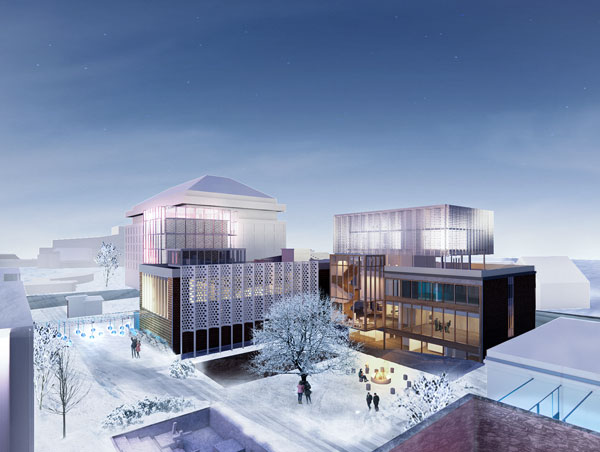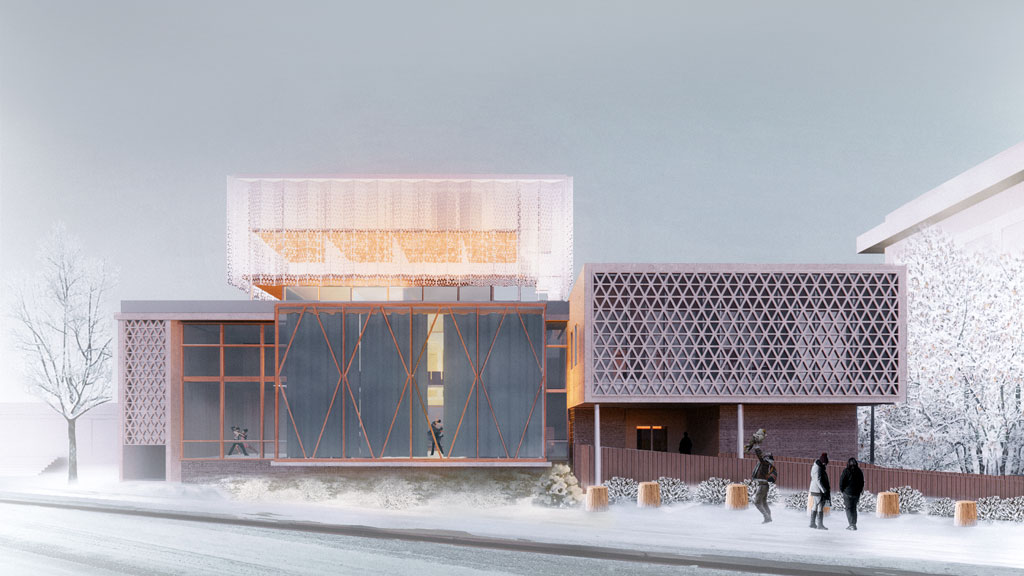A University of Waterloo architecture professor took 90 students outside the classroom to perform an adaptive reuse design exercise on a real-world building, the 63-year-old former Waterloo Regional Police Service building on Frederick Street in downtown Kitchener.
The results of some of the second-year students’ efforts were surprising — particularly one by 20-year-old Loriane Wong.
Wong, who took inspiration from the limestone edifice’s original drawings of 1958, “when hand drafting was an art form,” repurposed the facade to enliven the building while paying homage to its past, says Rick Haldenby, the architecture professor who oversaw the exercise.
“I wanted to reinterpret the interesting language of the existing, hovering wrapped volume,” in part by adding precast screens to the facade, Wong told the Daily Commercial News.
Titling her project “Hover, Wrap, Connect” Wong says her design is an effort to create “a community hub” for the city.
“It ties into the history of the building while creating a strong identity for its future,” Wong said from Vancouver where she is working as an intern in her school co-op term for architectural firm Campos Studio.
Haldenby is impressed with her work.
Only half-way through her second year, the young student “is doing drawings that would do a professional proud,” he points out.
“She clearly understood the original design. Her insights were at a very high level.”
Wong’s plan includes 20 studios, a 225-seat main theatre and a 120-seat incubation theatre. She sees the building as a connection between the public and artists.

Haldenby says he is hopeful that Wong’s and the work of other second-year students will be exhibited to the public and that their designs might influence the municipality on future development in the core.
He says while private-public investment in development was evenly split between 1993 and 2017 in the core of Kitchener, today most projects are in the hands of private developers.
The design exercise on adaptive reuse is in keeping with Haldenby’s belief in repurposing old building stock, including a number of significant post Second World War commercial buildings, rather than replacing them.
He says the city has seen unprecedented commercial/residential development in recent years that will double the core’s population. Not all of that development will enhance the core, however.
“My program is focussed on having our community understand the value of what it has and having it look critically at the present boom in construction.”
Last spring Haldenby published a guide to the transformation of the core area that includes an hour’s walking tour of 20 active construction projects which when completed will see the area’s population grow by thousands in both workers and new residents.
The guide (Inten-City) also identifies four eras of development leading up to the current boom which started in 2018.Haldenby also led a design studio/exercise with fourth-year architecture students last summer on the impact of fast-paced development on the city’s public space and cultural institutions. It culminated in an exhibition for the public and community leaders.
The professor of architecture says both the second- and fourth-year design exercises were conducted with input from community stakeholders including arts groups, municipal planners, politicians and developers.
This kind of exercise for students at architecture schools throughout the province is rare.
“I think it is a really valuable experience for students at the start of their careers.”
While the pandemic has slowed new construction in Kitchener partly because of supply chain and labour issues, it is hard to say if that will translate to an increase in adaptive reuse projects, he says.
“There is a lot of serious examination in many areas associated with reuse…true costs of demolition, embodied energy, life cycle analysis.”
Wong sees adaptive reuse as not only important from a sustainability standpoint but also because it “continues the culture of a certain place.”
“For me these projects are really exciting because you learn what has been there and you have to work with what’s given to you instead of starting from scratch.”



Recent Comments
comments for this post are closed